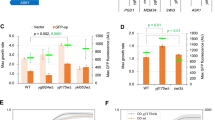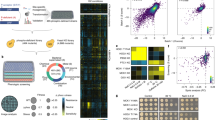Abstract
Reversible protein phosphorylation is a major regulatory mechanism in a cell. A chemical-genetic strategy to conditionally inactivate protein kinases has been developed recently. Mutating a single residue in the ATP-binding pocket confers sensitivity to small-molecule inhibitors. The inhibitor can only bind to the mutant kinase and not to any other wild-type kinase, allowing specific inactivation of the modified kinase. Here, we describe a protocol to construct conditional analog-sensitive kinase alleles in the fission yeast Schizosaccharomyces pombe. This protocol can be completed in about 3 weeks and should be applicable to other organisms as well.
This is a preview of subscription content, access via your institution
Access options
Subscribe to this journal
Receive 12 print issues and online access
$259.00 per year
only $21.58 per issue
Buy this article
- Purchase on Springer Link
- Instant access to full article PDF
Prices may be subject to local taxes which are calculated during checkout




Similar content being viewed by others
References
Zeidler, M.P. et al. Temperature-sensitive control of protein activity by conditionally splicing inteins. Nat. Biotechnol. 22, 871–876 (2004).
Dohmen, R.J., Wu, P. & Varshavsky, A. Heat-inducible degron: a method for constructing temperature-sensitive mutants. Science 263, 1273–1276 (1994).
Gregan, J. et al. Fission yeast Cdc23/Mcm10 functions after pre-replicative complex formation to promote Cdc45 chromatin binding. Mol. Biol. Cell 14, 3876–3887 (2003).
Labib, K., Tercero, J.A. & Diffley, J.F. Uninterrupted MCM2-7 function required for DNA replication fork progression. Science 288, 1643–1647 (2000).
Nurse, P., Thuriaux, P. & Nasmyth, K. Genetic control of the cell division cycle in the fission yeast Schizosaccharomyces pombe. Mol. Gen. Genet. 146, 167–178 (1976).
Lindner, K., Gregan, J., Montgomery, S. & Kearsey, S.E. Essential role of MCM proteins in premeiotic DNA replication. Mol. Biol. Cell 13, 435–444 (2002).
Gregan, J. et al. Novel genes required for meiotic chromosome segregation are identified by a high-throughput knockout screen in fission yeast. Curr. Biol. 15, 1663–1669 (2005).
Knight, Z.A. & Shokat, K.M. Chemical genetics: where genetics and pharmacology meet. Cell 128, 425–430 (2007).
Carroll, A.S., Bishop, A.C., DeRisi, J.L., Shokat, K.M. & O'Shea, E.K. Chemical inhibition of the Pho85 cyclin-dependent kinase reveals a role in the environmental stress response. Proc. Natl. Acad. Sci. USA 98, 12578–12583 (2001).
Davies, S.P., Reddy, H., Caivano, M. & Cohen, P. Specificity and mechanism of action of some commonly used protein kinase inhibitors. Biochem. J. 351, 95–105 (2000).
Bishop, A.C. et al. A chemical switch for inhibitor-sensitive alleles of any protein kinase. Nature 407, 395–401 (2000).
Buzko, O. & Shokat, K.M. A kinase sequence database: sequence alignments and family assignment. Bioinformatics 18, 1274–1275 (2002).
Burkard, M.E. et al. Chemical genetics reveals the requirement for polo-like kinase 1 activity in positioning RhoA and triggering cytokinesis in human cells. Proc. Natl. Acad. Sci. USA 104, 4383–4388 (2007).
Wan, L., Zhang, C., Shokat, K.M. & Hollingsworth, N.M. Chemical inactivation of cdc7 kinase in budding yeast results in a reversible arrest that allows efficient cell synchronization prior to meiotic recombination. Genetics 174, 1767–1774 (2006).
Ventura, J.J. et al. Chemical genetic analysis of the time course of signal transduction by JNK. Mol. Cell 21, 701–710 (2006).
Pinsky, B.A., Kung, C., Shokat, K.M. & Biggins, S. The Ipl1-aurora protein kinase activates the spindle checkpoint by creating unattached kinetochores. Nat. Cell Biol. 8, 78–83 (2006).
D'Aquino, K.E. et al. The protein kinase Kin4 inhibits exit from mitosis in response to spindle position defects. Mol. Cell 19, 223–234 (2005).
Jones, M.H. et al. Chemical genetics reveals a role for Mps1 kinase in kinetochore attachment during mitosis. Curr. Biol. 15, 160–165 (2005).
Habelhah, H. et al. Identification of new JNK substrate using ATP pocket mutant JNK and a corresponding ATP analogue. J. Biol. Chem. 276, 18090–18095 (2001).
Shokat, K. & Velleca, M. Novel chemical genetic approaches to the discovery of signal transduction inhibitors. Drug Discov. Today 7, 872–879 (2002).
Shah, K. & Shokat, K.M. A chemical genetic screen for direct v-Src substrates reveals ordered assembly of a retrograde signaling pathway. Chem. Biol. 9, 35–47 (2002).
Hwang, Y.W. & Miller, D.L. A mutation that alters the nucleotide specificity of elongation factor Tu, a GTP regulatory protein. J. Biol. Chem. 262, 13081–13085 (1987).
Hoffman, H.E., Blair, E.R., Johndrow, J.E. & Bishop, A.C. Allele-specific inhibitors of protein tyrosine phosphatases. J. Am. Chem. Soc. 127, 2824–2825 (2005).
Holt, J.R. et al. A chemical-genetic strategy implicates myosin-1c in adaptation by hair cells. Cell 108, 371–381 (2002).
Gillespie, P.G., Gillespie, S.K., Mercer, J.A., Shah, K. & Shokat, K.M. Engineering of the myosin-ibeta nucleotide-binding pocket to create selective sensitivity to N(6)-modified ADP analogs. J. Biol. Chem. 274, 31373–31381 (1999).
Kapoor, T.M. & Mitchison, T.J. Allele-specific activators and inhibitors for kinesin. Proc. Natl. Acad. Sci. USA 96, 9106–9111 (1999).
Zhang, C. et al. A second-site suppressor strategy for chemical genetic analysis of diverse protein kinases. Nat. Methods 2, 435–441 (2005).
Wood, V. et al. The genome sequence of Schizosaccharomyces pombe. Nature 415, 871–880 (2002).
Kearney, P.H., Ebert, M. & Kuret, J. Molecular cloning and sequence analysis of two novel fission yeast casein kinase-1 isoforms. Biochem. Biophys. Res. Commun. 203, 231–236 (1994).
Dhillon, N. & Hoekstra, M.F. Characterization of two protein kinases from Schizosaccharomyces pombe involved in the regulation of DNA repair. EMBO J. 13, 2777–2788 (1994).
Petronczki, M. et al. Monopolar attachment of sister kinetochores at meiosis I requires casein kinase 1. Cell 126, 1049–1064 (2006).
Cohen, S.N., Chang, A.C. & Hsu, L. Nonchromosomal antibiotic resistance in bacteria: genetic transformation of Escherichia coli by R-factor DNA. Proc. Natl. Acad. Sci. USA 69, 2110–2114 (1972).
Gregan, J. et al. High-throughput knockout screen in fission yeast. Nat. Protoc. 1, 2457–2464 (2006).
Larochelle, S. et al. Requirements for Cdk7 in the assembly of Cdk1/cyclin B and activation of Cdk2 revealed by chemical genetics in human cells. Mol. Cell 25, 839–850 (2007).
Jaeschke, A. et al. JNK2 is a positive regulator of the cJun transcription factor. Mol. Cell 23, 899–911 (2006).
Acknowledgements
This work was supported by the Austrian Science Fund (P18955-B03). L.C. was a recipient of EMBO and FEBS short-term fellowships. We thank Mark Petronczki and Maria Siomos for helpful discussions and comments on the manuscript.
Author information
Authors and Affiliations
Corresponding author
Supplementary information
Supplementary Table 1
S. pombe protein kinases with the corresponding gate-keeper residue. (DOC 48 kb)
Rights and permissions
About this article
Cite this article
Gregan, J., Zhang, C., Rumpf, C. et al. Construction of conditional analog-sensitive kinase alleles in the fission yeast Schizosaccharomyces pombe. Nat Protoc 2, 2996–3000 (2007). https://doi.org/10.1038/nprot.2007.447
Published:
Issue Date:
DOI: https://doi.org/10.1038/nprot.2007.447
This article is cited by
-
A phosphoinositide hub connects CLE peptide signaling and polar auxin efflux regulation
Nature Communications (2023)
-
RNA metabolism is the primary target of formamide in vivo
Scientific Reports (2017)
-
Synchronized fission yeast meiosis using an ATP analog–sensitive Pat1 protein kinase
Nature Protocols (2014)
-
Lifespan extension by calorie restriction relies on the Sty1 MAP kinase stress pathway
The EMBO Journal (2010)
-
Receptor-like kinases shape the plant
Nature Cell Biology (2009)
Comments
By submitting a comment you agree to abide by our Terms and Community Guidelines. If you find something abusive or that does not comply with our terms or guidelines please flag it as inappropriate.



